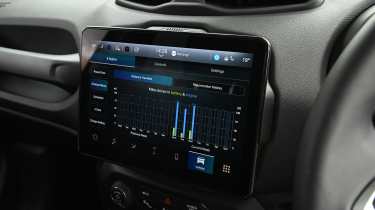In addition, the Renegade 4xe has a smaller fuel tank than the e-Hybrid model to make space for the larger plug-in battery. At 36.5 litres it’s nearly 12 litres down, and if you don’t charge the battery when parked, this is going to cut the car’s overall range significantly. Either way, stops are going to be frequent to top up either the battery or the fuel tank.
| Model | MPG | CO2 | Insurance group |
| Renegade 1.5 E-Hybrid | 52.3mpg | 127g/km | 17 |
| Renegade 1.3 4xe PHEV | 134.5mpg | 48g/km | 26 |
Electric range, battery life and charge time
While the battery in the 4xe PHEV is small at 11.4kWh, that does mean it’s quick to top up when compared with a full EV. It can go from flat to fully charged in an hour and 40 minutes when plugged into a 7.4kWh wallbox, but that’s as fast a charging speed as you’ll get, because there are no quicker options available.
| Model | Battery size | Range | Insurance group |
| Renegade 1.3 4xe PHEV | 11.4kWh | 30 miles | 26 |
Insurance groups
The complexity of the plug-in powertrain has a negative effect on insurance group ratings. The e-Hybrid model falls into group 17, but the 4xe is nearly 10 groups higher in 26.
Tax
All versions of the Jeep Renegade fall below the £40,000 luxury car surcharge for road tax, so the 4xe will be a cheaper car to run than many other four-wheel-drive SUVs.
Depreciation
There’s a retained value of around 43 per cent for the e-Hybrid version of the Renegade, which is at the lower end of the spectrum in the small SUV class, but not shocking. However, the 4xe falls to 37 per cent, which is pretty poor. This isn’t the worst performer in the Jeep line-up, though, because the Compass has even less impressive residuals.
Ageing interior will appeal to some because of its switches, but they’re not well laid out

Pros |
|
Cons |
|
The Renegade’s cabin was designed back in the early 2010s, so it looks quite dated today, and features plenty of hard plastics. But since the Renegade is an older car, it also has a lot of physical controls instead of touchscreen functions, which will be a bonus for some people. Some of the controls aren’t that logically laid out, while the fuel filler release on the PHEV model – it’s a safety feature to prevent opening the filler while the car is on charge, to help prevent the risk of fire – looks a bit like an aftermarket addition. As well as the touchscreen and climate controls, a third bank of switches sits beneath the climate settings to change the off-road modes.
Interior and dashboard design
Inside, Jeep squeezes in plenty of character touches. The Jeep ‘face’ of round headlights and seven-slot grille is embossed into the rear-view mirror housing, speaker surrounds and tailgate. The air vent design is apparently inspired by base-jumping equipment, the pod-like central vents by ski goggles, and you even get a mud splatter graphic instead of a red line on the rev counter.
Materials and build quality
Hard plastics are the order of the day, but as with other off-road biased models, the Renegade makes a virtue of this and incorporates it into the design.

Infotainment, sat-nav and stereo – subhead H3
There’s a modest 10-inch touchscreen inside, while the driver gets a 10.25-inch display ahead of the steering wheel that shows loads of information. The main screen has plenty of functionality, with Bluetooth included alongside Apple CarPlay and Android Auto, allowing you to bypass the native infotainment system if you want.


